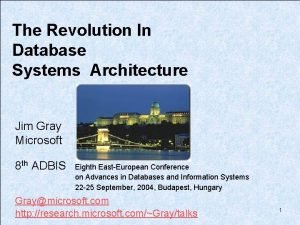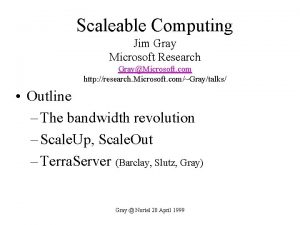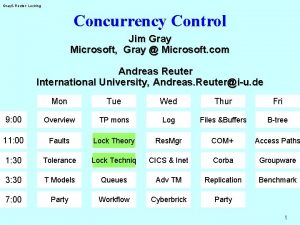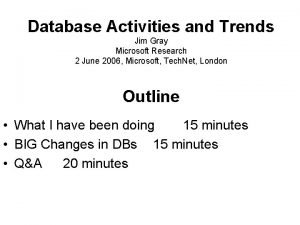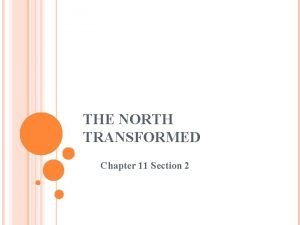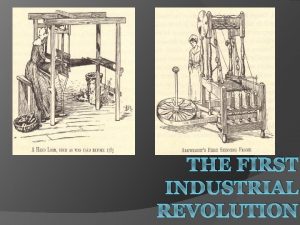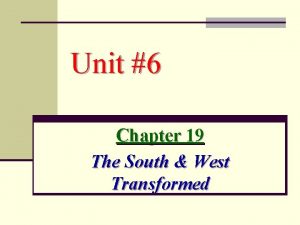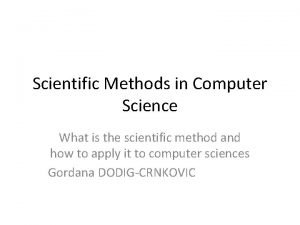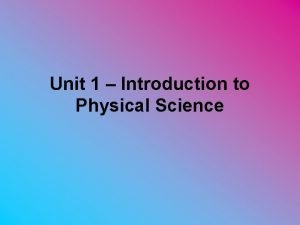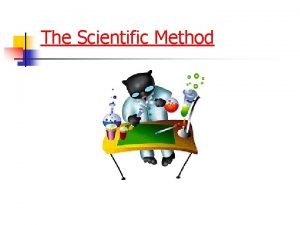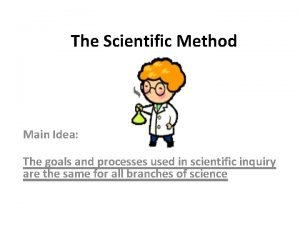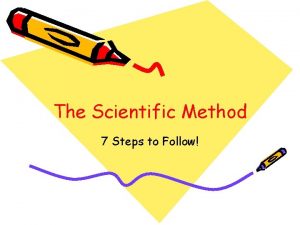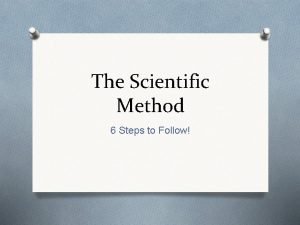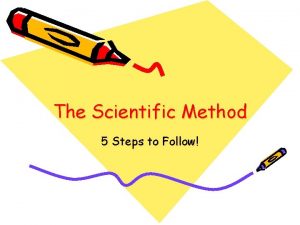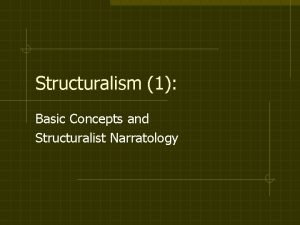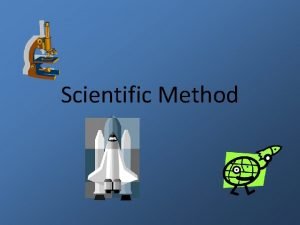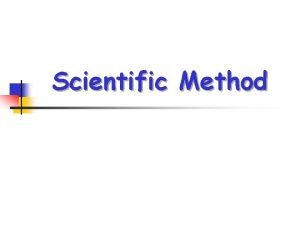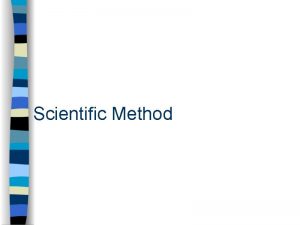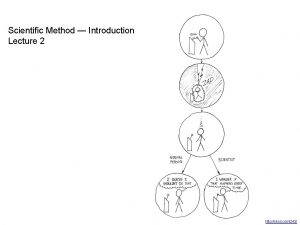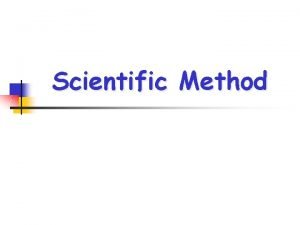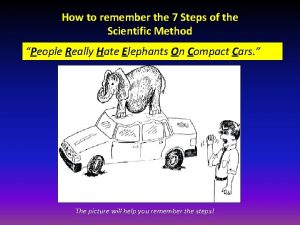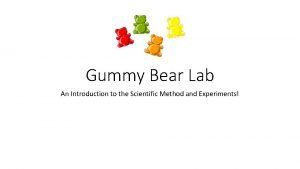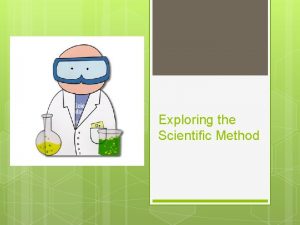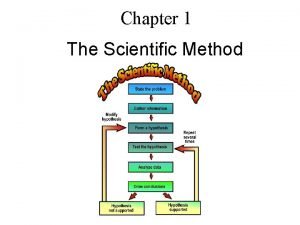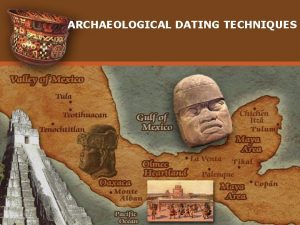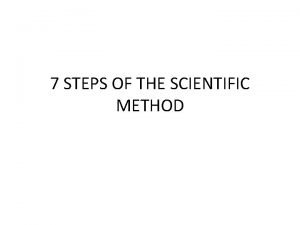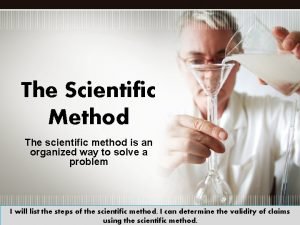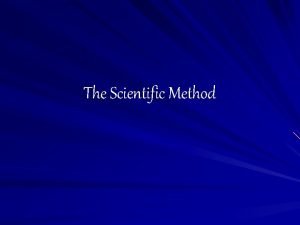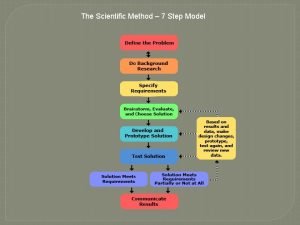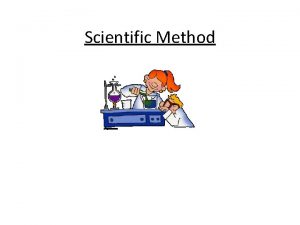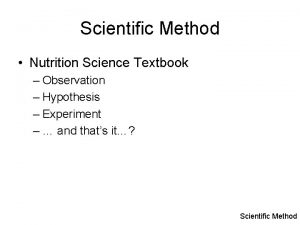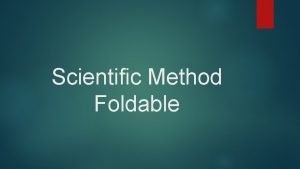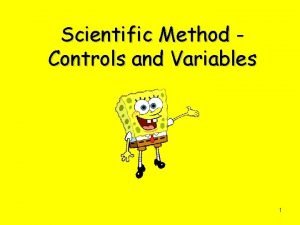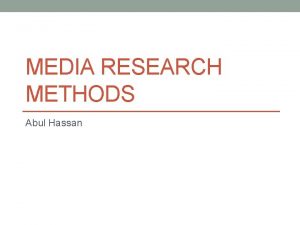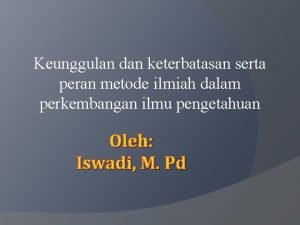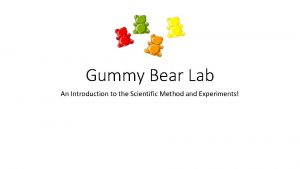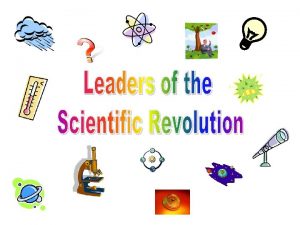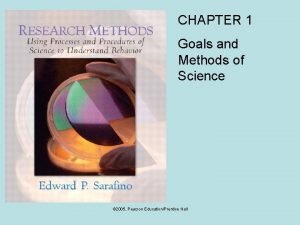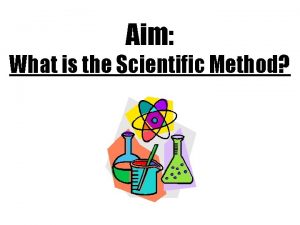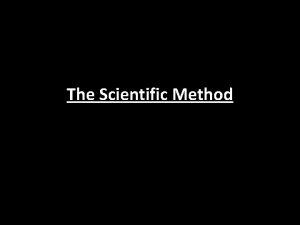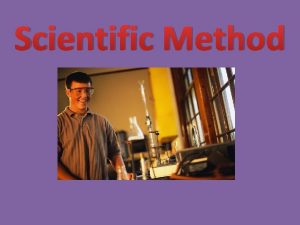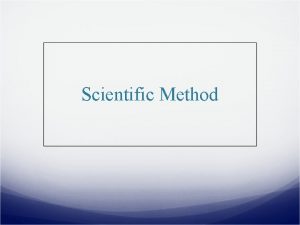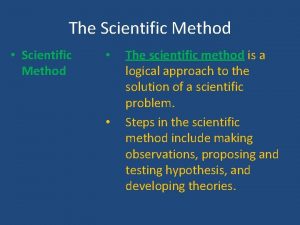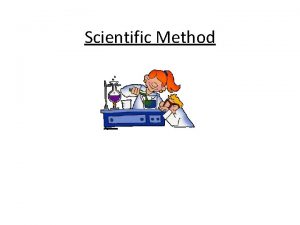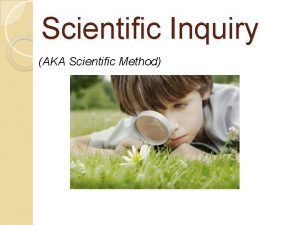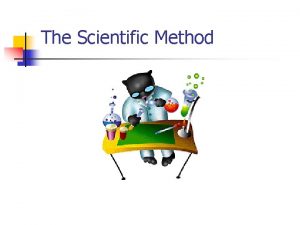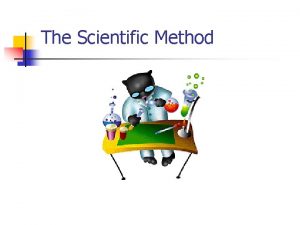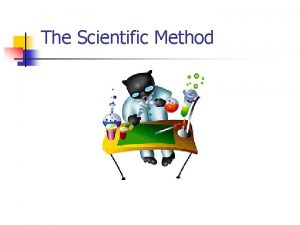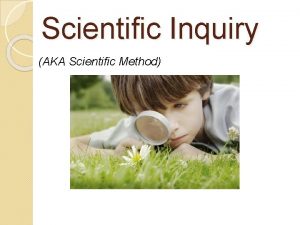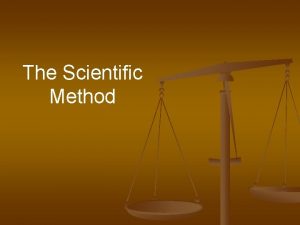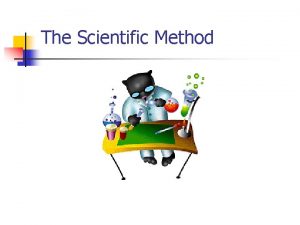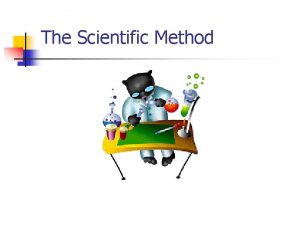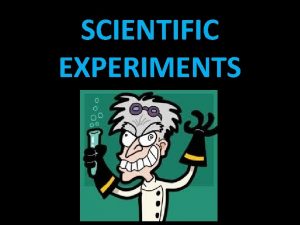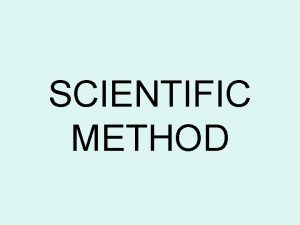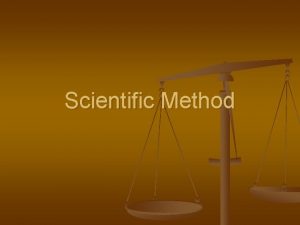e Science A Transformed Scientific Method Jim Gray


























































- Slides: 58

e. Science -- A Transformed Scientific Method Jim Gray, e. Science Group, Microsoft Research http: //research. microsoft. com/~Gray in collaboration with Alex Szalay Dept. Physics & Astronomy Johns Hopkins University http: //www. sdss. jhu. edu/~szalay/

Talk Goals Explain e. Science (and what I am doing) & Recommend CSTB foster tools for • data capture (lab info management systems) • data curation (schemas, ontologies, provenance) • data analysis (workflow, algorithms, databases, data visualization ) • data+doc publication (active docs, data-doc integration) • peer review (editorial services) • access (doc + data archives and overlay journals) • Scholarly communication (wiki’s for each article and dataset)

e. Science: What is it? • Synthesis of information technology and science. • Science methods are evolving (tools). • Science is being codified/objectified. How represent scientific information and knowledge in computers? • Science faces a data deluge. How to manage and analyze information? • Scientific communication changing publishing data & literature (curation, access, preservation)

Science Paradigms • Thousand years ago: science was empirical describing natural phenomena • Last few hundred years: theoretical branch using models, generalizations • Last few decades: a computational branch simulating complex phenomena • Today: data exploration (e. Science) unify theory, experiment, and simulation – Data captured by instruments Or generated by simulator – Processed by software – Information/Knowledge stored in computer – Scientist analyzes database / files using data management and statistics

X-Info • The evolution of X-Info and Comp-X for each discipline X • How to codify and represent our knowledge Experiments & f Instruments acts facts Other Archives Literature facts a f Simulations questions ? answers The Generic Problems • • • Data ingest Managing a petabyte Common schema How to organize it How to reorganize it How to share with others • • • Query and Vis tools Building and executing models Integrating data and Literature Documenting experiments Curation and long-term preservation

Experiment Budgets ¼…½ Software for • Instrument scheduling • Instrument control • Data gathering • Data reduction • Database • Analysis • Modeling • Visualization Millions of lines of code Repeated for experiment after experiment Not much sharing or learning CS can change this Build generic tools • Workflow schedulers • Databases and libraries • Analysis packages • Visualizers • …

Experiment Budgets ¼…½ Software Millions of lines of code Software for • Instrument scheduling Repeated for experiment after experiment • Instrument control Not much sharing or learning • Data gathering Action item CS can change this • Data reduction Foster Tools and Build generic tools • Database • Workflow schedulers Support • Analysis. Foster Tool • Databases and libraries • Modeling • Analysis packages • Visualization • Visualizers • …

Project Pyramids In most disciplines there a few “giga” projects, several “mega” consortia and then many small labs. Often some instrument creates need for giga-or mega-project Polar station International Accelerator Telescope Remote sensor Multi-Campus Genome sequencer Supercomputer Tier 1, 2, 3 facilities to use instrument + data Single Lab

Pyramid Funding • Giga Projects need Giga Funding Major Research Equipment Grants • Need projects at all scales • computing example: supercomputers, + departmental clusters + lab clusters • technical+ social issues • Fully fund giga projects, fund ½ of smaller projects they get matching funds from other sources • “Petascale Computational Systems: Balanced Cyber-Infrastructure in a Data-Centric World , ” IEEE Computer, V. 39. 1, pp 110 -112, January, 2006.

Action item Invest in tools at all levels

Need Lab Info Management Systems (LIMSs) • Pipeline Instrument + Simulator data to archive & publish to web. • NASA Level 0 (raw) data Level 1 (calibrated) Level 2 (derived) • Needs workflow tool to manage pipeline • Build prototypes. • Examples: – SDSS, Life. Under. Your. Feet MBARI Shore Side Data System.

Need Lab Info Management Systems (LIMSs) • Pipeline Instrument + Simulator data to archive & publish to web. • NASA Level 0 (raw) data Level 1 (calibrated) Action item Level 2 (derived) • Needs workflow tool to manage pipeline Foster generic LIMS • Build prototypes. • Examples: – SDSS, Life. Under. Your. Feet MBARI Shore Side Data System.

Science Needs Info Management • Simulators produce lots of data • Experiments produce lots of data • Standard practice: – each simulation run produces a file – each instrument-day produces a file – each process step produces a file – files have descriptive names – files have similar formats (described elsewhere) • Projects have millions of files (or soon will) • No easy way to manage or analyze the data.

Data Analysis • Looking for – Needles in haystacks – the Higgs particle – Haystacks: Dark matter, Dark energy • Needles are easier than haystacks • Global statistics have poor scaling – Correlation functions are N 2, likelihood techniques N 3 • We can only do N log. N • Must accept approximate answers New algorithms • Requires combination of – statistics & – computer science

Analysis and Databases • Much statistical analysis deals with – – – – – Creating uniform samples – data filtering Assembling relevant subsets Estimating completeness Censoring bad data Counting and building histograms Generating Monte-Carlo subsets Likelihood calculations Hypothesis testing • Traditionally performed on files • These tasks better done in structured store with – – – indexing, aggregation, parallelism query, analysis, visualization tools.

Data Delivery: Hitting a Wall FTP and GREP are not adequate • • You can GREP 1 MB in a second • You can GREP 1 GB in a minute • You can GREP 1 TB in 2 days • You can GREP 1 PB in 3 years • You can FTP 1 MB in 1 sec FTP 1 GB / min (~1 $/GB) … 2 days and 1 K$ … 3 years and 1 M$ • Oh!, and 1 PB ~4, 000 disks • At some point you need indices to limit search parallel data search and analysis • This is where databases can help

Accessing Data • If there is too much data to move around, take the analysis to the data! • Do all data manipulations at database – Build custom procedures and functions in the database • Automatic parallelism guaranteed • Easy to build-in custom functionality – Databases & Procedures being unified – Example temporal and spatial indexing – Pixel processing • Easy to reorganize the data – Multiple views, each optimal for certain analyses – Building hierarchical summaries are trivial active databases! • Scalable to Petabyte datasets

Analysis and Databases • Much statistical analysis deals with • • – – – – – Creating uniform samples – data filtering Assembling relevant subsets Estimating completeness Censoring bad data Counting and building histograms Generating Monte-Carlo subsets Likelihood calculations Hypothesis testing – – aggregation, parallelism query, analysis, visualization tools. Action item Foster Data Management Data Analysis Traditionally performed on files Data Visualization These tasks better done in structured store with – indexing, Algorithms &Tools

Let 100 Flowers Bloom • Comp-X has some nice tools – Beowulf – Condor – BOINC – Matlab • These tools grew from the community • It’s HARD to see a common pattern – Linux vs Free. BSD why was Linux more successful? Community, personality, timing, …. ? ? ? • Lesson: let 100 flowers bloom.

Talk Goals Explain e. Science (and what I am doing) & Recommend CSTB foster tools and tools for • data capture (lab info management systems) • data curation (schemas, ontologies, provenance) • data analysis (workflow, algorithms, databases, data visualization ) • data+doc publication (active docs, data-doc integration) • peer review (editorial services) • access (doc + data archives and overlay journals) • Scholarly communication (wiki’s for each article and dataset)

All Scientific Data Online • Many disciplines overlap and use data from other sciences. • Internet can unify Literature all literature and data • Go from literature Derived and to computation Re-combined data to data back to literature. Raw Data • Information at your fingertips For everyone-everywhere • Increase Scientific Information Velocity • Huge increase in Science Productivity

Unlocking Peer-Reviewed Literature • Agencies and Foundations mandating research be public domain. – NIH (30 B$/y, 40 k PIs, …) (see http: //www. taxpayeraccess. org/) – Welcome Trust – Japan, China, Italy, South Africa, . … – Public Library of Science. . • Other agencies will follow NIH

How Does the New Library Work? • Who pays for storage access (unfunded mandate)? – Its cheap: 1 milli-dollar per access • But… curation is not cheap: – – Author/Title/Subject/Citation/…. . Dublin Core is great but… NLM has a 6, 000 -line XSD for documents http: //dtd. nlm. nih. gov/publishing Need to capture document structure from author • Sections, figures, equations, citations, … • Automate curation – NCBI-Pub. Med. Central is doing this • Preparing for 1 M articles/year – Automate it!

Pub Med Central International • “Information at your fingertips” • Deployed US, China, England, Italy, South Africa, Japan • UK PMCI http: //ukpmc. ac. uk/ • Each site can accept documents • Archives replicated • Federate thru web services • Working to integrate Word/Excel/… with Pubmed. Central – e. g. Word. ML, XSD, • To be clear: NCBI is doing 99. 99% of the work.

Overlay Journals • Articles and Data in public archives • Journal title page in public archive. • All covered by Creative Commons License – permits: copy/distribute – requires: attribution http: //creativecommons. org/ articles Data Archives Data Sets

Overlay Journals • Articles and Data in public archives • Journal title page in public archive. • All covered by Creative Commons License Journal Management System – permits: copy/distribute – requires: attribution http: //creativecommons. org/ Data Archives Data Sets title page articles

Overlay Journals • Articles and Data in public archives • Journal title page in public archive. • All covered by Creative Commons License Journal Management System – permits: copy/distribute – requires: attribution http: //creativecommons. org/ Data Archives Data Sets Journal Collaboration System comments title page articles

Overlay Journals • Articles and Data in public archives Action item • Journal title page in public Journal archive. Collaboration Management Do for other sciences System • All covered by Creative what NLM has done for BIO Commons License Genbank-Pub. Med. Centralcomments … – permits: copy/distribute – requires: attribution http: //creativecommons. org/ Data Archives Data Sets title page articles

Better Authoring Tools • Extend Authoring tools to – capture document metadata (NLM tagset) – represent documents in standard format • Word. ML (ECMA standard) – capture references – Make active documents (words and data). • Easier for authors • Easier for archives

Conference Management Tool • Currently a conference peer-review system (~300 conferences) – Form committee – Accept Manuscripts – Declare interest/recuse – Review – Decide – Form program – Notify – Revise

Publishing Peer Review • Add publishing steps & improve author-reader experience – Form committee • Manage versions – Accept Manuscripts • Capture data – Declare interest/recuse • Interactive documents – Review • Capture Workshop • presentations – Decide • proceedings – Form program • Capture classroom – Notify Conference. XP – Revise • Moderated discussions – Publish of published articles • Connect to Archives

Why Not a Wiki? • Peer-Review is different – It is very structured – It is moderated – There is a degree of confidentiality • Wiki is egalitarian – It’s a conversation – It’s completely transparent • Don’t get me wrong: – – Wiki’s are great Share. Points are great But. . Peer-Review is different. And, incidentally: review of proposals, projects, … is more like peer-review. • Let’s have Moderated Wiki re published literature PLo. S-One is doing this

Why Not a Wiki? • Peer-Review is different • • – It is very structured – It is moderated – There is a degree of confidentiality Action item Wiki is egalitarian Foster new document – It’s a conversation – It’s completely transparent authoring and publication Don’t get me wrong: – Wiki’s are great models and tools – Share. Points are great – But. . Peer-Review is different. – And, incidentally: review of proposals, projects, … is more like peer-review. • Let’s have Moderated Wiki re published literature PLo. S-One is doing this

So… What about Publishing Data? • The answer is 42. • But… – What are the units? – How precise? How accurate 42. 5 ±. 01 – Show your work data provenance

Thought Experiment • You have collected some data and want to publish science based on it. • How do you publish the data so that others can read it and reproduce your results in 100 years? – Document collection process? – How document data processing (scrubbing & reducing the data)? – Where do you put it?

Objectifying Knowledge • This requires agreement about – Units: cgs – Measurements: who/what/when/where/how – CONCEPTS: • What’s a planet, star, galaxy, …? • What’s a gene, protein, pathway…? • Need to objectify science: – what are the objects? – what are the attributes? – What are the methods (in the OO sense)? • This is mostly Physics/Bio/Econ/. . . But CS can do generic things

Objectifying Knowledge • This requires agreement about Warning! – Units: cgs – Measurements: who/what/when/where/how Painful discussions ahead: – CONCEPTS: • What’s a planet, star, galaxy, …? • What’s a gene, protein, pathway…? The “O” word: Ontology • Need to objectify science: The “S” word: Schema – what are the objects? The– “CV” words: what are the attributes? – What are the methods (in the OO sense)? Controlled Vocabulary • This is mostly Physics/Bio/Econ/. . . Domain experts do not agree But CS can do generic things

The Best Example: Entrez-Gen. Bank http: //www. ncbi. nlm. nih. gov/ • • Sequence data deposited with Genbank Literature references Genbank ID BLAST searches Genbank Entrez integrates and searches – – – – Pub. Med. Central Pub. Chem Genbank Proteins, SNP, Structure, . . Taxonomy… Many more Pub. Med Publishers Pub. Med abstracts Taxon Phylogeny Nucleotide sequences Entrez Complete Genomes Genome Centers 3 -D Structure Protein sequences MMDB

Publishing Data Roles Authors Publishers Curators Consumers Traditional Scientists Journals Libraries Scientists Emerging Collaborations Project www site Bigger Archives Scientists • Exponential growth: – Projects last at least 3 -5 years – Data sent upwards only at the end of the project – Data will never be centralized • More responsibility on projects – Becoming Publishers and Curators • Data will reside with projects – Analyses must be close to the data

Data Pyramid • Very extended distribution of data sets: data on all scales! • Most datasets are small, and manually maintained (Excel spreadsheets) • Total volume dominated by multi-TB archives • But, small datasets have real value • Most data is born digital collected via electronic sensors or generated by simulators.

Data Sharing/Publishing • What is the business model (reward/career benefit)? • Three tiers (power law!!!) (a) big projects (b) value added, refereed products (c) ad-hoc data, on-line sensors, images, outreach info • • • We have largely done (a) Need “Journal for Data” to solve (b) Need “VO-Flickr” (a simple interface) (c) Mashups are emerging in science Need an integrated environment for ‘virtual excursions’ for education (C. Wong)

The Best Example: Entrez-Gen. Bank http: //www. ncbi. nlm. nih. gov/ • • Sequence data deposited with Genbank Literature references Genbank ID Action item BLAST searches Genbank Foster Digital Data Libraries Entrez integrates and searches (not metadata, real data) and integration with literature – – – – Pub. Med. Central Pub. Chem Genbank Proteins, SNP, Structure, . . Taxonomy… Many more Pub. Med Publishers Pub. Med abstracts Taxon Phylogeny Nucleotide sequences Entrez Complete Genomes Genome Centers 3 -D Structure Protein sequences MMDB

Talk Goals Explain e. Science (and what I am doing) & Recommend CSTB foster tools and tools for • data capture (lab info management systems) • data curation (schemas, ontologies, provenance) • data analysis (workflow, algorithms, databases, data visualization ) • data+doc publication (active docs, data-doc integration) • peer review (editorial services) • access (doc + data archives and overlay journals) • Scholarly communication (wiki’s for each article and dataset)

backup •

Astronomy • Help build world-wide telescope – All astronomy data and literature online and cross indexed – Tools to analyze the data • Built Sky. Server. SDSS. org • Built Analysis system – My. DB – Cas. Jobs (batch job) • Open. Sky. Query Federation of ~20 observatories. • Results: – – It works and is used every day Spatial extensions in SQL 2005 A good example of Data Grid Good examples of Web Services.

World Wide Telescope Virtual Observatory http: //www. us-vo. org/ http: //www. ivoa. net/ • Premise: Most data is (or could be online) • So, the Internet is the world’s best telescope: – – It has data on every part of the sky In every measured spectral band: optical, x-ray, radio. . As deep as the best instruments (2 years ago). It is up when you are up. The “seeing” is always great (no working at night, no clouds no moons no. . ). – It’s a smart telescope: links objects and data to literature on them.

Why Astronomy Data? IRAS 25 m • It has no commercial value –No privacy concerns –Can freely share results with others –Great for experimenting with algorithms 2 MASS 2 m • It is real and well documented –High-dimensional data (with confidence intervals) –Spatial data –Temporal data • Many different instruments from many different places and many different times • Federation is a goal • There is a lot of it (petabytes) DSS Optical IRAS 100 m WENSS 92 cm NVSS 20 cm ROSAT ~ke. V GB 6 cm

Time and Spectral Dimensions The Multiwavelength Crab Nebulae Crab star 1053 AD X-ray, optical, infrared, and radio views of the nearby Crab Nebula, which is now in a state of chaotic expansion after a supernova explosion first sighted in 1054 A. D. by Chinese Astronomers. Slide courtesy of Robert Brunner @ Cal. Tech.

Sky. Server. SDSS. org • A modern archive – Access to Sloan Digital Sky Survey Spectroscopic and Optical surveys – Raw Pixel data lives in file servers – Catalog data (derived objects) lives in Database – Online query to any and all • Also used for education – 150 hours of online Astronomy – Implicitly teaches data analysis • Interesting things – – – Spatial data search Client query interface via Java Applet Query from Emacs, Python, …. Cloned by other surveys (a template design) Web services are core of it.

Sky. Server. SDSS. org • Like the Terra. Server, but looking the other way: a picture of ¼ of the universe • Sloan Digital Sky Survey Data: Pixels + Data Mining • About 400 attributes per “object” • Spectrograms for 1% of objects

Demo of Sky. Server • • • Shows standard web server Pixel/image data Point and click Explore one object Explore sets of objects (data mining)

Sky. Query (http: //skyquery. net/) • Distributed Query tool using a set of web services • Many astronomy archives from Pasadena, Chicago, Baltimore, Cambridge (England) • Has grown from 4 to 15 archives, now becoming international standard • Web. Service Poster Child • Allows queries like: SELECT o. obj. Id, o. r, o. type, t. obj. Id FROM SDSS: Photo. Primary o, TWOMASS: Photo. Primary t WHERE XMATCH(o, t)<3. 5 AND AREA(181. 3, -0. 76, 6. 5) AND o. type=3 and (o. I - t. m_j)>2

Sky. Query Structure • Each Sky. Node publishes – Schema Web Service – Database Web Service • Portal is – Plans Query (2 phase) – Integrates answers – Is itself a web service Image Cutout SDSS Sky. Query Portal FIRST 2 MASS INT

Sky. Server/Sky. Query Evolution My. DB and Batch Jobs Problem: need multi-step data analysis (not just single query). Solution: Allow personal databases on portal Problem: some queries are monsters Solution: “Batch schedule” on portal. Deposits answer in personal database.

Ecosystem Sensor Net Life. Under. Your. Feet. Org • Small sensor net monitoring soil • Sensors feed to a database • Helping build system to collect & organize data. • Working on data analysis tools • Prototype for other LIMS Laboratory Information Management Systems

RNA Structural Genomics • Goal: Predict secondary and tertiary structure from sequence. Deduce tree of life. • Technique: Analyze sequence variations sharing a common structure across tree of life • Representing structurally aligned sequences is a key challenge • Creating a database-driven alignment workbench accessing public and private sequence data

VHA Health Informatics • VHA: largest standardized electronic medical records system in US. • Design, populate and tune a ~20 TB Data Warehouse and Analytics environment • Evaluate population health and treatment outcomes, • Support epidemiological studies – – – 7 million enrollees 5 million patients Example Milestones: • 1 Billionth Vital Sign loaded in April ‘ 06 • 30 -minutes to population-wide obesity analysis (next slide) • Discovered seasonality in blood pressure -- NEJM fall ‘ 06

HDR Vitals Based Body Mass Index Calculation on VHA FY 04 Population Source: VHA Corporate Data Warehouse Total Patients 23, 876 (0. 7%) 701, 089 (21. 6%) 1, 177, 093 (36. 2%) 1, 347, 098 (41. 5%) 3, 249, 156 (100%)
 Jim gray database
Jim gray database What happened to terraserver
What happened to terraserver Microsoft flow concurrency control
Microsoft flow concurrency control Jim gray microsoft
Jim gray microsoft Scientific inquiry vs scientific method
Scientific inquiry vs scientific method Www.sciencebuddies.org
Www.sciencebuddies.org What is my favourite subject
What is my favourite subject The north transformed
The north transformed Recovery community
Recovery community The transformed school counselor
The transformed school counselor What is the transformative process of operations management
What is the transformative process of operations management Difference between conform and transform
Difference between conform and transform Lives transformed
Lives transformed An industry transformed
An industry transformed What is a pure soul
What is a pure soul The south and west transformed
The south and west transformed How is a scientific law different from a scientific theory?
How is a scientific law different from a scientific theory? What is symposium method
What is symposium method 6 manipulative skills
6 manipulative skills Scientific methods in computer science
Scientific methods in computer science K h d m d c m chart
K h d m d c m chart The science of scientific writing
The science of scientific writing 7 steps of the scientific method
7 steps of the scientific method 7 steps of the scientific method
7 steps of the scientific method Thalidomide babies
Thalidomide babies Brainpop independent and dependent variables
Brainpop independent and dependent variables 7 steps of scientific inquiry
7 steps of scientific inquiry What are the 6 steps of the scientific method?
What are the 6 steps of the scientific method? 5 steps of scientific method
5 steps of scientific method How does the scientific method work
How does the scientific method work Scientific method psychology
Scientific method psychology Importance of scientific method
Importance of scientific method Examples of scientific method
Examples of scientific method Scientific method steps
Scientific method steps M&m experiments with scientific method
M&m experiments with scientific method Scientific method learning objectives
Scientific method learning objectives Xkcd scientific method
Xkcd scientific method Scientific method steps
Scientific method steps What is the order of the scientific method
What is the order of the scientific method How to remember the 7 steps of the scientific method
How to remember the 7 steps of the scientific method Gummy bear density lab answer key
Gummy bear density lab answer key Exploring the scientific method
Exploring the scientific method What is the fourth step of the scientific method
What is the fourth step of the scientific method Sir mortimer wheeler scientific and soil layer method
Sir mortimer wheeler scientific and soil layer method 7 steps of the scientific method
7 steps of the scientific method Scientific method of observation
Scientific method of observation Examples of problems using scientific method
Examples of problems using scientific method Scientific method involves
Scientific method involves What is the step in scientific method
What is the step in scientific method What is the step in scientific method
What is the step in scientific method Scientific method nutrition
Scientific method nutrition Scientific method foldable
Scientific method foldable Scientific method controls and variables
Scientific method controls and variables Scientific method characteristics
Scientific method characteristics Limitations of the scientific method
Limitations of the scientific method Gummy drop rules
Gummy drop rules Francis bacon rene descartes
Francis bacon rene descartes Scientific method characteristics
Scientific method characteristics Scientific method aim
Scientific method aim
